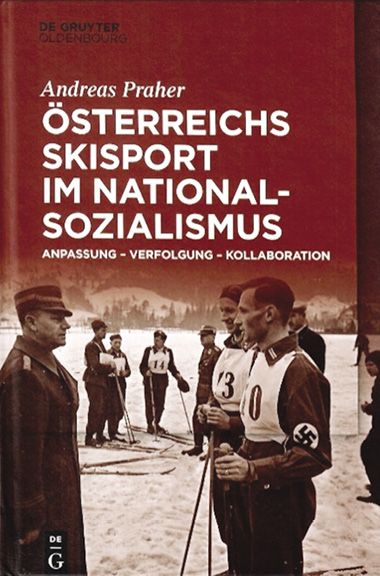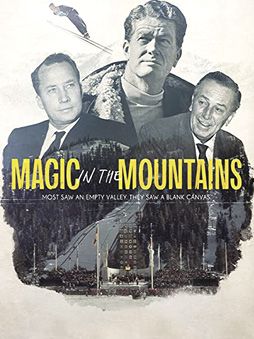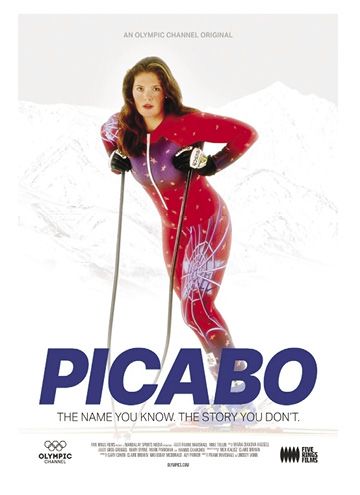Reviews: Eldora history, skiing under Nazi rule, winning films
Eldora: Six Decades of Adventure
By Rett Ertl and Andy Bigford
For its 60th anniversary, Eldora Resort in Nederland, Colorado, published this handsome, profusely illustrated history. I hesitate to call it a coffee table book, because it’s not a massive photo collection printed on glossy stock, peppered with marketing-driven captions. Instead, it’s a usefully detailed history, warts and all, of a family-oriented local ski area that took five decades to mature into a booming backyard playground for Boulder’s hard-body athletes and their kids.
The story is told by Rett Ertl, whose father took over ownership and management of the resort in 1967, and co-author Andy Bigford, former SKI magazine editor, ISHA award winner and a member of the Skiing History editorial advisory board. From the beginning, Eldora faced an uphill slog: before snowmaking, each winter was a gamble, and high winds blew natural snow into the woods. County commissioners discouraged investment by forbidding the construction of lodging. Lack of capital, and, more critically, lack of snow, crippled the enterprise. The only things Eldora had going for it were interesting terrain and proximity to the Denver/Boulder market. The new owner, Tell Ertl, Ph.D., was a very successful oil geologist and mining engineer who got results on the ground: snowmaking, new lifts, trail improvements.
Tell himself admitted that buying the resort wasn’t a sound business decision, but he loved to ski and moved his wife and five kids into a tiny apartment in the patrol shack. For the next 18 winters, Eldora was a classic mom-and-pop operation. Tell died of cancer, at age 60, in 1975, turning management over to his accountant; Rett took over in 1982, interrupting a promising career selling IBM equipment to Russia. By this time Eldora faced competition from major resorts along the I-70 corridor, which was easily accessible through the Eisenhower Tunnel, which opened in 1979. By 1985 the family was ready to sell. A new owner defaulted; the lifts never turned in 1986–87.
Eldora wound up in the hands of industry veterans Chuck Lewis and Andy Daly. In 1991, ownership finally stabilized as a partnership among Lewis, ex-racer and insurance exec Graham Anderson and Bill Killebrew, who had recently sold Heavenly Valley. Killebrew drove serious infrastructure investment, creating the largest snowmaking system in Colorado, several new lifts and a base lodge. He became majority owner.
Under Killebrew, Eldora achieved steady profitability. Between 1967, when Ertl took charge, and 1991, when Killebrew came aboard, the population of Boulder County more than doubled, and it rose another 50 percent over the next three decades. Thanks to the University of Colorado, the population skews young. Eldora became the place for young families to learn to ski, especially as traffic on the I-70 corridor clotted to a standstill on weekends.
In 2016, ownership passed to John Cummings and his POWDR Corp.; Cummings lost no time installing a high-speed quad and base-lodge improvements. Eldora soon joined Alterra’s Ikon Pass empire, expanding the customer base from Boulder County to the entire Colorado Front Range.
Eldora: Six Decades of Adventure, by Rett Ertl and Andy Bigford; published by Eldora, 2023, ISBN 979-8-218-02335-5, hardcover, 135 pages ($22.48 discounted at the Eldora website).

Österreichs Skisport im National-Sozialismus: Anpassung-Verfolgung-Kollaboration (Austrian Ski Sport in the Nazi Era: Adaptation-Persecution-Collaboration)
By Andreas Praher
This is an important work on a sensitive topic, long overlooked. Most of us are aware that North American skiing benefited from an influx of refugee skiers, many of them veteran instructors, after the Nazis took power in Germany in 1933 and, especially, after Austrian and Swiss instructors were excluded from the Garmisch Olympics in 1936. Even before the Anschluss in 1938, conditions in Europe led Walter Prager, Otto Schniebs, Benno Rybizka, Otto Lang, Friedl Pfeifer, Nick Hock, Ernie Bloch, Walter Neuron and many more to cross the Atlantic; the Anschluss forced more, most prominently Hannes Schneider, to follow. American ski schools improved, and in 1941 the nascent 10th Mountain Division had a ready cadre of skiing drill sergeants. What we don’t often consider is what happened to skiers who stayed in Europe.
In this book, a winner of ISHA’s Ullr Award, Andreas Praher provides a partial answer, addressing Austria specifically (the story remains to be told for skiing in Nazi-occupied Europe and Vichy France, and for organized skiing behind the Iron Curtain). Praher, a Ph.D. historian at the University of Salzburg, points out that Nazi influence on skiing didn’t begin with the Anschluss. Instead, Nazi ideology crept into organized Austrian skiing by stages, leading to policies of “exclusion” within the ÖSV (Austrian Ski Federation) well before establishment of the national dictatorship. One result was that ski-sport organizations became, in effect, collaborationist.
Praher focuses on individual stories, showing how people on both sides—perpetrators and victims—responded to ideological pressure. He carries the story into the postwar aftermath, up to 1955—a period when skiing and ski racing served as a rallying point for a revived nationalism, and some wartime criminals were rehabilitated as sports heroes.
The book is in German, but Praher promises an English-language condensation, to run as an article in a future edition of Skiing History.
Österreichs Skisport im National-Sozialismus: Anpassung -Verfolgung-Kollaboration (Austrian Ski Sport in the Nazi Era: Adaptation-Persecution-Collaboration), by Andreas Praher. Walter de Gruyter GmbH, Berlin/Boston. https://www.degruyter.com/document/doi/10.1515/9783110724127/html?lang=de (2022), hardcover, 462 pages, $58 (Amazon.com $45.46)
ISHA Film Awards

Magic in the Mountains
Featuring much never-before-seen footage, Magic in the Mountains tells the early history of Squaw Valley, from Wayne Poulsen’s discovery of the place to the triumph of the 1960 Olympics. The first half of the film focuses on Poulsen and his partner and nemesis, Alex Cushing, using interviews with Russel and Eric Poulsen, Nancy Cushing and Alexandra Cushing Howard and Eddy Ancinas, with comments by historian Dave Antonucci. Due credit is accorded George Weller and Jo Marillac for helping to bring the Olympics to Squaw. The second half focuses on Walt Disney and key Disney executives like Tommy Walker, who brought Squaw Valley—and the Olympic movement—into the television age. Olympic firsts in 1960 included live broadcast, the athlete’s village, mechanical grooming, refrigerated rinks, precision electronic timing and real-time data processing—and even the first use of instant replay in judging.
The strength of this film lies in its portrayals of Poulsen, Cushing and Disney. Poulsen and Cushing, both omnicompetent, were opposites in temperament, their brief partnership doomed. Disney combined Poulsen’s love of the sport with Cushing’s commercial ambition and added his century’s keenest talent for showmanship.
80 minutes, streaming on Amazon Prime.

Picabo
By Lindsey Vonn and Frank Marshall
From co-directors and executive producers Frank Marshall and Lindsey Vonn comes Picabo, the first career-spanning film chronicling the life of Picabo Street, the alpine skiing icon of the 1990s and Vonn’s childhood hero. From her unorthodox childhood in Idaho to her Olympic successes, dramatic recoveries from ill-timed injuries and her arrest in 2015 due to false allegations, the film provides an intimate look at Street’s fascinating life through an emotional interview with Vonn and behind-the-scenes footage of Street. 
90 minutes, streaming on olympics.com/en/films/watch/picabo-five-rings-films
